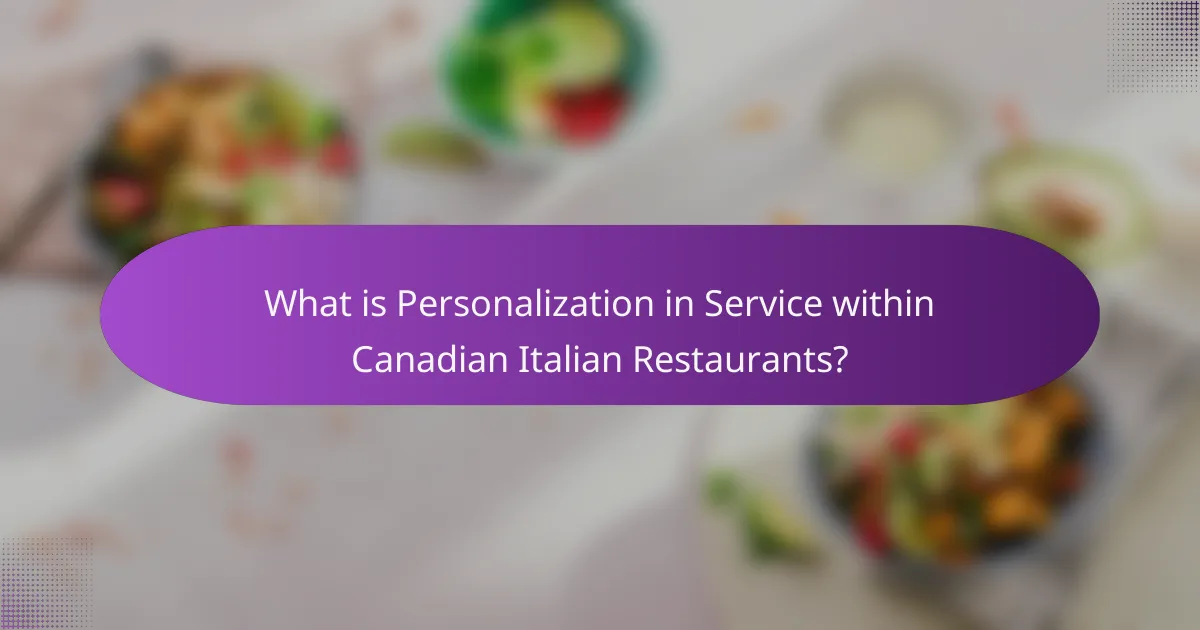
What is Personalization in Service within Canadian Italian Restaurants?
Personalization in service within Canadian Italian restaurants refers to tailoring the dining experience to meet individual customer preferences. This can include customizing menu items based on dietary restrictions or flavor preferences. Restaurants may also offer personalized greetings and attentive service based on previous visits. A study by the Canadian Restaurant and Foodservices Association highlights that 70% of diners appreciate personalized recommendations. This approach enhances customer satisfaction and loyalty. By understanding and addressing individual tastes, these restaurants create a unique and memorable dining experience.
How do Canadian Italian restaurants define personalization in service?
Canadian Italian restaurants define personalization in service as a tailored dining experience that addresses individual customer preferences. They achieve this by offering customized menu options based on dietary restrictions and preferences. Staff members often engage with customers to understand their tastes and make recommendations. This approach enhances customer satisfaction and fosters loyalty. Many restaurants also utilize customer data to remember previous orders and preferences. For example, a restaurant may recall a customer’s favorite dish or wine. This level of attention to detail creates a unique dining atmosphere. Ultimately, personalization in service is about making each guest feel valued and understood.
What are the key elements of personalized service in this context?
Key elements of personalized service in Canadian Italian restaurants include understanding customer preferences, tailoring menu options, and providing attentive service. Understanding customer preferences involves gathering information about dietary restrictions and favorite dishes. Tailoring menu options means offering customizable meals based on individual tastes. Providing attentive service ensures staff are responsive to customer needs and feedback. These elements contribute to a unique dining experience, enhancing customer satisfaction and loyalty.
How does personalization enhance the dining experience for guests?
Personalization enhances the dining experience for guests by tailoring the service to individual preferences. This approach creates a sense of belonging and recognition for diners. Personalized menus can accommodate dietary restrictions and preferences, ensuring satisfaction. Staff training in customer engagement fosters relationships with regular patrons. According to a study by the National Restaurant Association, 70% of consumers are more likely to return to a restaurant that remembers their preferences. Personalized experiences can also lead to increased customer loyalty and positive word-of-mouth. Overall, personalization transforms a standard meal into a memorable occasion.
Why is personalization important for Canadian Italian restaurants?
Personalization is important for Canadian Italian restaurants because it enhances customer satisfaction and loyalty. Tailoring the dining experience to individual preferences makes patrons feel valued. This approach can lead to repeat business, which is crucial in the competitive food industry. Studies show that personalized service can increase customer retention rates by up to 30%. Additionally, offering customized menu options can cater to diverse dietary needs, attracting a broader clientele. Engaging with customers through personalized recommendations fosters a sense of community and connection. Ultimately, personalization differentiates restaurants in a crowded market, driving both revenue and reputation.
What impact does personalization have on customer satisfaction?
Personalization significantly enhances customer satisfaction. It allows businesses to tailor experiences based on individual preferences. This customization leads to a stronger emotional connection with customers. Research shows that 80% of consumers are more likely to make a purchase when brands offer personalized experiences. Additionally, personalized services can increase customer loyalty and retention. A study by Epsilon revealed that 90% of consumers find personalization appealing. This indicates that personalization is not just a trend but a critical factor in customer satisfaction.
How does personalization influence customer loyalty in the restaurant industry?
Personalization significantly enhances customer loyalty in the restaurant industry. When restaurants tailor experiences to individual preferences, customers feel valued and understood. This approach fosters emotional connections between customers and the brand. According to a study by Deloitte, 36% of consumers express a preference for personalized experiences. Personalized recommendations can lead to increased frequency of visits and higher spend per visit. Furthermore, 80% of consumers are more likely to make a purchase when offered personalized experiences. In the competitive landscape of dining, personalization can be a key differentiator that retains customers.

What methods do Canadian Italian restaurants use to personalize service?
Canadian Italian restaurants use several methods to personalize service. They often train staff to remember regular customers’ names and preferences. This creates a welcoming atmosphere. Many restaurants offer customized menu options based on dietary restrictions or preferences. For example, gluten-free or vegan alternatives are commonly available.
Additionally, some establishments use customer feedback to tailor their offerings. They may adjust recipes or introduce new dishes based on popular demand. Seasonal menus are also a common practice, allowing restaurants to showcase local ingredients.
Technology plays a role in personalization as well. Many Canadian Italian restaurants utilize reservation systems that store customer preferences. This data helps staff provide a more personalized experience during visits. These methods collectively enhance the dining experience, making it more enjoyable and tailored to individual guests.
How do restaurants gather information about customer preferences?
Restaurants gather information about customer preferences through various methods. They often use customer surveys to collect direct feedback. This feedback can include favorite dishes, dining experiences, and service quality. Many restaurants also analyze sales data to identify popular menu items. Loyalty programs track customer purchases and preferences over time. Social media interactions provide insights into customer opinions and trends. Additionally, staff observations during service can reveal customer likes and dislikes. These methods help restaurants tailor their offerings to enhance customer satisfaction.
What tools and technologies aid in understanding customer preferences?
Data analytics platforms aid in understanding customer preferences. These platforms analyze customer behavior and purchasing patterns. Customer Relationship Management (CRM) systems store detailed customer profiles. They track interactions and preferences over time. Social media monitoring tools gauge customer sentiment and feedback. They provide insights into trends and preferences. Surveys and feedback forms collect direct customer opinions. They help refine offerings based on customer input. Artificial Intelligence (AI) algorithms predict preferences based on historical data. These technologies enhance personalization in service delivery.
How do staff training programs contribute to personalized service?
Staff training programs enhance personalized service by equipping employees with skills to understand customer needs. Trained staff can recognize individual preferences and tailor their interactions accordingly. This leads to improved customer satisfaction and loyalty. A study by the American Society for Training and Development found that effective training increases employee engagement by 70%. Engaged employees are more likely to provide exceptional service. Furthermore, training programs often include role-playing scenarios that prepare staff for real-life situations. This practice helps employees develop empathy and effective communication skills. Overall, well-structured training directly influences the quality of personalized service in Canadian Italian restaurants.
What specific practices are employed for personalization in service?
Canadian Italian restaurants employ several specific practices for personalization in service. They often utilize customer data to tailor dining experiences. This includes remembering previous orders and preferences. Staff may recommend dishes based on individual tastes. They also adjust menu items to accommodate dietary restrictions. Personalized greetings and interactions enhance the customer experience. Seasonal ingredients are often used to create unique dishes for returning customers. Feedback is actively sought to improve service and offerings. This approach fosters customer loyalty and satisfaction.
How do menu customization options cater to individual tastes?
Menu customization options allow individuals to tailor their dining experience to their specific preferences. This personalization is achieved through various choices in ingredients, portion sizes, and cooking styles. Customers can select toppings, sauces, and sides that align with their tastes. For instance, a diner may prefer gluten-free pasta or extra vegetables. Restaurants often provide these options to enhance customer satisfaction. Studies show that personalized menus can increase repeat visits by 30%. This reflects the growing demand for unique dining experiences that cater to individual palates.
What role does customer feedback play in enhancing service personalization?
Customer feedback is crucial for enhancing service personalization. It provides insights into individual customer preferences and experiences. By analyzing feedback, businesses can identify specific needs and desires. This information allows restaurants to tailor their services accordingly. For example, a restaurant may adjust menu items based on customer taste preferences. Research shows that 70% of customers are more likely to return if their feedback is acknowledged. This reinforces the importance of listening to customers for service improvement. Ultimately, utilizing feedback fosters a more personalized dining experience.

What challenges do Canadian Italian restaurants face in implementing personalization?
Canadian Italian restaurants face several challenges in implementing personalization. One challenge is the diverse customer base with varying preferences and dietary restrictions. This diversity complicates menu customization and requires careful consideration of ingredients. Another challenge is the limited resources available for staff training on personalized service. Many restaurants operate with small teams, making it hard to focus on individualized customer interactions. Additionally, integrating technology for personalized experiences can be costly and complex. Many establishments lack the budget for sophisticated customer relationship management systems. Finally, maintaining consistency in personalized service can be difficult. Staff turnover can lead to variations in service quality, affecting customer satisfaction.
What are common obstacles in personalizing service effectively?
Common obstacles in personalizing service effectively include data limitations, staff training, and customer privacy concerns. Data limitations arise when restaurants lack sufficient customer information to tailor experiences. Inadequate data can lead to generic service offerings that do not meet individual preferences. Staff training is crucial; without proper training, employees may struggle to implement personalized service strategies. This can result in inconsistent customer experiences. Additionally, customer privacy concerns can hinder personalization efforts. Many customers are wary of sharing personal information, which restricts the data available for tailoring services. These factors collectively challenge the ability of Canadian Italian restaurants to effectively personalize their services.
How can resource limitations affect personalization efforts?
Resource limitations can significantly hinder personalization efforts in service industries. Limited financial resources restrict the ability to gather and analyze customer data effectively. This reduction in data insights leads to a less tailored customer experience. Insufficient staff can also limit the capacity to engage with customers on a personal level. When employees are overworked, they may not have the time to understand individual preferences. Additionally, inadequate technology can prevent the implementation of advanced personalization tools. For instance, without proper CRM systems, tracking customer interactions becomes challenging. A study by McKinsey found that companies with robust personalization strategies can achieve 10-15% revenue increases. However, without the necessary resources, businesses may struggle to leverage such strategies effectively.
What strategies can be used to overcome these challenges?
Canadian Italian restaurants can use several strategies to overcome challenges in personalization. First, they can implement customer feedback systems. These systems allow diners to express their preferences and experiences. Second, they can utilize data analytics to track customer orders and preferences. This data can inform menu adjustments and personalized service. Third, staff training is essential. Well-trained staff can better understand and respond to individual customer needs. Fourth, offering customizable menu options enhances personalization. Customers appreciate the ability to tailor their meals. Lastly, leveraging technology, like mobile apps for ordering, can streamline the personalization process. These strategies collectively enhance customer satisfaction and loyalty in Canadian Italian restaurants.
How do cultural factors influence personalization in service?
Cultural factors significantly influence personalization in service by shaping customer expectations and preferences. Different cultures have distinct values, communication styles, and traditions that affect how individuals perceive service. For instance, in collectivist cultures, customers may prioritize group harmony and expect services to cater to family or community needs. In contrast, individualistic cultures often emphasize personal choice and self-expression in service experiences. Research shows that understanding these cultural nuances can enhance customer satisfaction and loyalty. A study by Hofstede (1980) highlights how cultural dimensions, such as uncertainty avoidance and power distance, impact service interactions. This understanding allows service providers, like Canadian Italian restaurants, to tailor their offerings to meet diverse customer needs effectively.
What unique aspects of Italian culture impact service personalization in Canada?
Italian culture emphasizes strong familial ties and community connections. This cultural aspect influences service personalization in Canadian Italian restaurants. Staff often engage with customers as if they are part of the family. This creates a welcoming environment that encourages customer loyalty.
Additionally, Italian dining traditions prioritize the experience over mere consumption. Meals are seen as social events, prompting restaurants to tailor services to enhance the dining experience. Personalized recommendations based on customer preferences are common.
Furthermore, the Italian value of hospitality plays a significant role. Restaurant staff are trained to anticipate needs and adapt services accordingly. This attention to detail fosters a unique dining atmosphere that resonates with customers.
These cultural elements collectively shape how Canadian Italian restaurants personalize their services, ensuring a memorable experience for each guest.
How do regional preferences shape personalization practices in different areas?
Regional preferences significantly influence personalization practices in various areas. These preferences include cultural tastes, local ingredients, and dining customs. For example, Canadian Italian restaurants may adapt their menus to incorporate locally sourced ingredients favored by the community. Additionally, regional dining habits, such as family-style sharing or individual servings, can shape how meals are served. Restaurants often conduct surveys and analyze customer feedback to understand these local preferences better. This data allows them to tailor their offerings, ensuring they resonate with the local clientele. Studies show that 70% of consumers prefer brands that understand their individual needs. Therefore, regional preferences are crucial for effective personalization in the restaurant industry.
What are the best practices for enhancing personalization in service?
Best practices for enhancing personalization in service include understanding customer preferences, utilizing data analytics, and training staff effectively. Understanding customer preferences allows businesses to tailor experiences to individual needs. Data analytics helps in gathering insights from customer interactions. This information can inform personalized recommendations and offerings. Training staff to recognize and respond to customer cues enhances service quality. Implementing feedback loops allows continuous improvement in personalization efforts. Research indicates that personalized service can increase customer satisfaction by up to 20%.
How can restaurants leverage customer data for better personalization?
Restaurants can leverage customer data for better personalization by analyzing past dining behaviors. This includes tracking customer preferences, such as favorite dishes and dining frequency. Utilizing this data allows restaurants to tailor marketing efforts and menu suggestions. For example, personalized email promotions can be sent based on previous orders. Additionally, loyalty programs can be designed to reward frequent customers with tailored offers. According to a study by Salesforce, 70% of consumers say a company’s understanding of their personal preferences influences their loyalty. This demonstrates that data-driven personalization can enhance customer satisfaction and retention.
What role does continuous staff training play in maintaining personalized service?
Continuous staff training is essential for maintaining personalized service. It ensures that employees are knowledgeable about menu items and customer preferences. Training helps staff develop interpersonal skills that enhance guest interactions. Regular updates on service techniques keep the staff engaged and motivated. This fosters a culture of attentiveness and responsiveness to customer needs. According to a study by the American Society for Training and Development, companies that invest in training see a 24% increase in employee performance. This directly translates to better service quality and customer satisfaction in restaurants. Thus, continuous training is a key factor in delivering tailored dining experiences.
Personalization in service within Canadian Italian restaurants focuses on tailoring the dining experience to meet individual customer preferences, including customized menu options and attentive service. Key elements include understanding customer tastes, utilizing customer data, and providing personalized interactions, which enhance customer satisfaction and loyalty. The article explores the importance of personalization, its impact on customer retention, and the methods restaurants employ to gather and analyze customer preferences. Additionally, it addresses challenges faced in implementing personalization and best practices for effective service delivery. Cultural factors and regional preferences also play a significant role in shaping personalized dining experiences.


